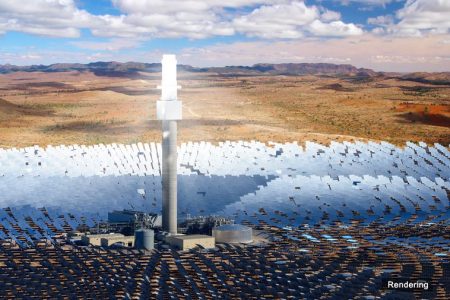January 11, 2018 – Solar panels are popping up all over Australia, but none are quite like the ones that will be featured in a new power plant to be built north of Port Augusta, in Australia. These solar panels in the state of South Australia are not photovoltaic. They do not convert light directly into electricity. Instead, they are heliostats, mirror-like panels, positioned in a large array to reflect incoming solar rays and focus them on a central tower where the light gets converted to heat which then can be used directly to create steam to drive turbines, or can be stored in a material called molten salt where it can later use the heat to power turbines when the sun is no longer shining.
Back in 2014, I posted a piece to 21st Century Tech blog entitled, “Molten Salt an Answer to Renewable Energy Intermittency.” In it, I described how this inert and non-toxic material (a mixture of sodium and potassium nitrate) is an ideal energy storage and generating medium that makes solar capable of providing 24×7 on-demand power, solving the intermittency issue that operators of older forms of power generation always point to as the major flaw of the renewable energy model. Peak load, on-demand coal, and natural gas carbon-emitting thermal plants will no longer be needed by utilities that incorporate this zero-emission technology, a significant step in transitioning to a lower carbon footprint.
The State of South Australia has been working on a plan to become less carbon-dependent and lately has made some headline-grabbing strides in this effort. The first involved Elon Musk’s company, Tesla, with the installation of a 100-megawatt lithium-ion battery attached to a wind farm near Jamestown in the state’s north.
The second is the approval of the solar-thermal power plant near Port Augusta, to be built by SolarReserve, a California-based solar energy company. The facility covers an area of 5 square kilometers (2 square miles). Its central tower stands nearly 200 meters (650 feet) in height. The molten salt reservoir is over 30 meters (100 feet) tall. Its operation is simple. The sun reflects off thousands of heliostats each focusing the light on the receiver at the top of the central tower. The light heats the molten salt within the tower complex to 565 Celsius (nearly 1,050 Fahrenheit) degrees. The heat is transferred to water circulating through pipes in the system turning into steam which then drives conventional steam turbines attached to generators.
The advantages of the SolarReserve design become apparent when night falls because the very hot molten salt does not lose its heat load significantly throughout the darkness, and can reliably keep turning water into steam, and steam into electricity, generating continuous power up to 150 megawatts, enough to provide light, heat and air conditioning to 90,000 Australian homes.
The construction of the solar-thermal plant is to begin almost immediately and will mark the completion of South Australia’s move away from a reliance on coal power. In 2016, the state shuttered its Alinta Energy coal-powered thermal plant. This followed the ending of operations at the Leigh Creek coal mine in 2015.
South Australia has already met its 50% renewable energy target a decade ahead of schedule. When completed the plant will eliminate the equivalent of 200,000 tons of carbon dioxide emissions annually.









